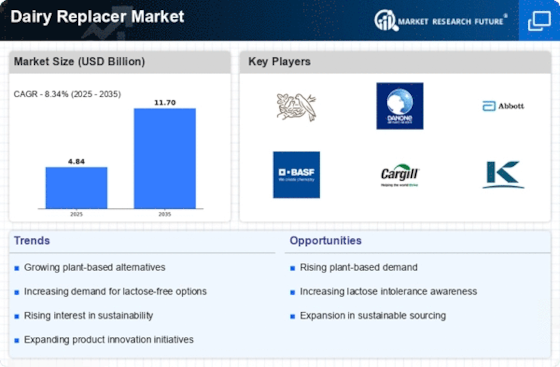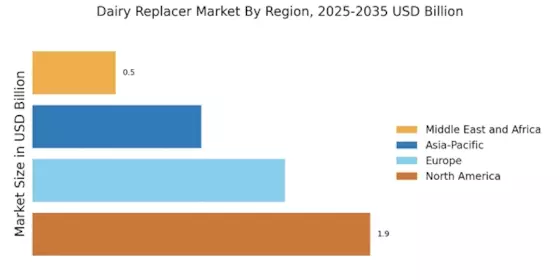Increasing Health Consciousness
The Dairy Replacer Market is experiencing a notable shift as consumers become increasingly health-conscious. This trend is driven by a growing awareness of dietary choices and their impact on health. Many individuals are opting for dairy replacers due to their perceived health benefits, such as lower cholesterol levels and reduced lactose intolerance symptoms. According to recent data, the demand for plant-based milk alternatives has surged, with almond and oat milk leading the charge. This shift indicates a broader acceptance of non-dairy options, suggesting that the Dairy Replacer Market is poised for continued growth as more consumers prioritize health in their dietary decisions.
Expansion of Distribution Channels
The expansion of distribution channels is a critical factor driving the Dairy Replacer Market. As consumer demand for dairy alternatives rises, retailers are increasingly stocking a wider variety of dairy replacers, making them more accessible to a broader audience. E-commerce platforms have also played a pivotal role in this expansion, allowing consumers to purchase dairy alternatives conveniently from home. Recent data indicates that online sales of plant-based products have surged, reflecting changing shopping habits. This increased availability not only enhances consumer choice but also encourages trial and adoption of dairy replacers, suggesting a positive trajectory for the Dairy Replacer Market.
Innovations in Product Development
Innovations in product development are significantly shaping the Dairy Replacer Market. Companies are increasingly investing in research and development to create new and improved dairy alternatives that cater to diverse consumer preferences. For instance, advancements in technology have led to the creation of dairy replacers that closely mimic the taste and texture of traditional dairy products. This innovation is crucial, as it addresses the concerns of consumers who may be hesitant to switch to non-dairy options. The introduction of fortified products, enriched with vitamins and minerals, further enhances the appeal of dairy replacers, potentially expanding their market share within the Dairy Replacer Market.
Rising Vegan and Vegetarian Populations
The rise in vegan and vegetarian populations is a significant driver for the Dairy Replacer Market. As more individuals adopt plant-based diets for ethical, environmental, or health reasons, the demand for dairy alternatives continues to grow. Recent statistics indicate that the number of people identifying as vegan has increased substantially, leading to a corresponding rise in the consumption of dairy replacers. This demographic shift not only influences purchasing behavior but also encourages food manufacturers to diversify their product offerings. Consequently, the Dairy Replacer Market is likely to see sustained growth as it adapts to the evolving preferences of a more plant-based-oriented consumer base.
Environmental Concerns and Sustainability
Environmental concerns are increasingly influencing consumer choices, thereby impacting the Dairy Replacer Market. As awareness of climate change and resource depletion grows, many consumers are seeking sustainable alternatives to traditional dairy products. Dairy replacers, often produced with a lower carbon footprint and reduced water usage, appeal to environmentally conscious consumers. This trend is reflected in market data, which shows a significant increase in the sales of plant-based products. Companies that prioritize sustainability in their production processes are likely to gain a competitive edge, suggesting that the Dairy Replacer Market will continue to evolve in response to these environmental considerations.


















Leave a Comment